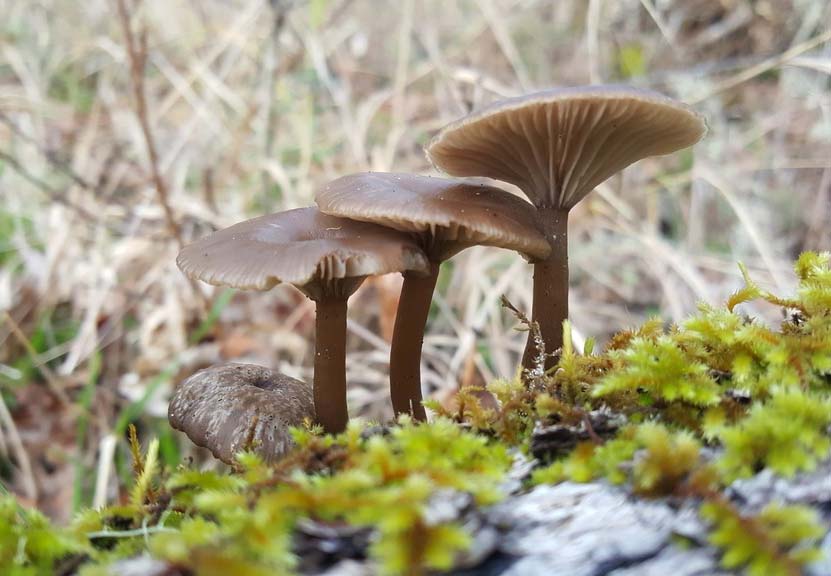
©
Bruce Newhouse
Danny’s DNA Discoveries – Pseudoclitocybaceae of the PNW (Tricholomatineae)
by Danny Miller
|
|
Danny’s DNA Discoveries – Pseudoclitocybaceae of the PNW (Tricholomatineae)
|
|
Introduction
The genera in this family are very, very similar. I don't think they should necessarily have been split, so feel free to think of these greyish brown funnel caps with strongly decurrent gills and indented caps in age collectively as Pseudoclitocybe s.l. or the Pseudoclitocybaceae. Even an ITS only tree shows these three genera cluster closely together in a family in the Tricholomatineae sub-order. They may or may not have clamp connections and inamyloid spores like Clitocybe, which they are easily confused with. Pseudoclitocybe - has smooth, amyloid spores (unlike Clitocybe's inamyloid spores). Harmajaea - a large, chalky-grey funnel cap that may be felty with a sometimes disagreeable odor and taste and possible greying flesh with smooth inamyloid spores like Clitocybe (and only recently separated on molecular evidence) but unlike most Clitocybe, lacking clamp connections. The lack of clamp connections may be the only reliable way to separate it from Clitopaxillus. Clitopaxillus - a very similar large chalky-grey funnel cap that also may be felty that browns in age with a mild odor/taste. It has smooth inamyloid spores and clamp connections, and therefore the hardest to separate from Clitocybe. Aspropaxillus - one of our largest gilled mushrooms, a huge funnel-shaped clitocyboid up to 40cm across. Clitocybe maxima and Infundibulicybe geotropa may also get large. Unpleasant odor and taste. Formerly in Leucopaxillus because the gills separate easily, but although large, these are not as dense as Leucopaxillus. Amyloid spores. abundant common uncommon rare - colour codes match my Pictorial Key and are my opinions and probably reflect my bias of living in W WA. Rare species may be locally common in certain places at certain times. |
 Pseudoclitocybe - click to expand Pseudoclitocybe - click to expand
large grey-brown funnel shaped clitocyboids with smooth, amyloid spores (unlike Clitocybe's inamyloid spores). When young, they may have quite an inrolled cap margin. Species mentioned: Pseudoclitocybe cyathiformis, expallens, oregonensis. |
 Harmajaea - click to expand Harmajaea - click to expand
A large, chalky-grey funnel cap that may be felty with a sometimes disagreeable odor and taste and greying flesh. The margin may be inrolled and the cap may have water spots. It has smooth inamyloid spores like Clitocybe (and only recently separated on molecular evidence) but unlike most Clitocybe, lacking clamp connections. The lack of clamp connections and sometimes disagreeable odor may be the only reliable way to separate it from Clitopaxillus, next. Species mentioned: Harmajaea harperi. |
 Clitopaxillus - click to
expand Clitopaxillus - click to
expand
very similar large chalky-grey funnel cap that also may be felty that browns in age with a mild odor/taste. The margin may be inrolled and the cap may have water spots. It has smooth inamyloid spores and clamp connections, and therefore the hardest to separate from Clitocybe. The clamp connections and always mild odor may be the only reliable way to separate it from Harmajaea, above. Species mentioned: Clitopaxillus alexandri. Clitocybe crassa, leopardina. |
 Aspropaxillus - click to
expand Aspropaxillus - click to
expand
One of our largest gilled mushrooms, a huge funnel-shaped clitocyboid up to 40cm across. Clitocybe maxima and Infundibulicybe geotropa may also get large. Unpleasant/farinaceous odor and taste. Formerly in Leucopaxillus because the gills separate easily, but although large, these are not as dense as Leucopaxillus. Amyloid spores. Species mentioned: Aspropaxillus giganteus, septentrionalis. |
 Musumecia - click to
expand Musumecia - click to
expand
Not known from the PNW until found by sequencing. Fairly nondescript for now. Species mentioned: Musumecia bettlachensis. |